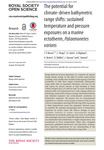Please use this identifier to cite or link to this item:
http://lib.hpu.edu.vn/handle/123456789/23542Full metadata record
| DC Field | Value | Language |
|---|---|---|
| dc.contributor.author | Morris, J. P. | en_US |
| dc.contributor.author | Thatje, S. | en_US |
| dc.contributor.author | Cottin, D. | en_US |
| dc.date.accessioned | 2016-10-11T05:37:11Z | |
| dc.date.available | 2016-10-11T05:37:11Z | |
| dc.date.issued | 2015 | en_US |
| dc.identifier.other | HPU4160653 | en_US |
| dc.identifier.uri | https://lib.hpu.edu.vn/handle/123456789/23542 | en_US |
| dc.description.abstract | Range shifts are of great importance as a response for species facing climate change. In the light of current ocean-surface warming, many studies have focused on the capacity of marine ectotherms to shift their ranges latitudinally. Bathymetric range shifts offer an important alternative, and may be the sole option for species already at high latitudes or those within enclosed seas yet relevant data are scant. Hydrostatic pressure (HP) and temperature have wide ranging effects on physiology, importantly acting in synergy thermodynamically, and therefore represent key environmental constraints to bathymetric migration. | en_US |
| dc.format.extent | 7 p. | en_US |
| dc.format.mimetype | application/pdf | en_US |
| dc.language.iso | en | en_US |
| dc.subject | Biology | en_US |
| dc.subject | Biochemistry | en_US |
| dc.subject | Environmental science | en_US |
| dc.subject | Temperature | en_US |
| dc.subject | Physiological scope | en_US |
| dc.title | The potential for climate-driven bathymetric range shifts | en_US |
| dc.type | Article | en_US |
| dc.size | 418KB | en_US |
| dc.department | Education | en_US |
| Appears in Collections: | Education | |
Files in This Item:
| File | Description | Size | Format | |
|---|---|---|---|---|
| 0536_Thepotential.pdf Restricted Access | 418.99 kB | Adobe PDF |  View/Open Request a copy |
Items in DSpace are protected by copyright, with all rights reserved, unless otherwise indicated.
